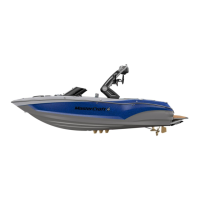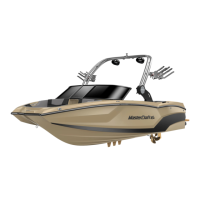• Check under the coupling to be certain that the ball clamp is
below the ball and not riding on top of the ball.
• Lock the coupler to the hitch ball. To confirm that the coupler is
locked onto the hitch ball, lift up on the trailer using the jack. If
the trailer coupler comes loose from the hitch ball, unlock and go
back to the third step above.
• After the coupler is properly locked on to the hitch ball, be certain
that the trailer jack is in the fully raised and locked position.
• Attach the surge break-away cable to the tow vehicle, making
sure there is enough slack for tight turns.
• Attach the safety cables.
• Connect the trailer’s seven-wire connector to the seven-wire
connector of the tow vehicle and check the operation of the trailer
lights.
Trailer Tips And Techniques
With a boat trailer in tow, an operator will be driving down the road
with a vehicle combination that is longer, heavier and sometimes
wider and taller than the tow vehicle. This means the operator
should make a few adjustments to normal driving practices to com-
pensate for the differences.
Use common sense
MasterCraft cannot anticipate every type of situation in which driv-
ers may find themselves. The following recommendations apply to
general situations, but it is up to the individual driver to properly and
safely act or react as a given situation requires.
Take a shakedown cruise.
Before making the first major trip or lake cruise with a MasterCraft
trailer, make at least one short trial run to become familiar with its
handling characteristics.
Be sure everything is working properly
Slow down
There is less strain on the tow vehicle, trailer and boat at moderate
to slow speeds. Also, many states have lower speed limits for vehi-
cles towing trailers. Driving at moderate speeds will place less strain
on the tow vehicle and the trailer. Trailer instability (sway) is more
likely to occur as speed increases. Particular attention needs to be
given to all aspects of towing when traveling over bumpy roads and
railroad crossings.
Allow extra time and space
You’ll need more of both when passing and stopping.
Pass with extra care
Signal well in advance and make sure you allow extra distance
to clear the vehicle you are passing before you pull back into the
lane. Pass on level terrain with plenty of clearance. Avoid passing
on steep up or down grades. Down shift as necessary to improve
acceleration or speed maintenance. When passing on narrow roads,

